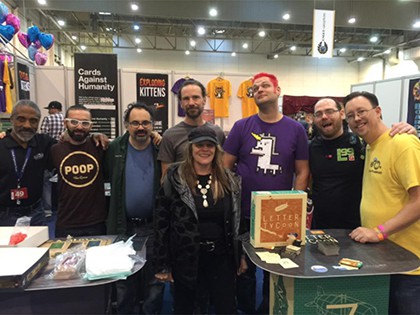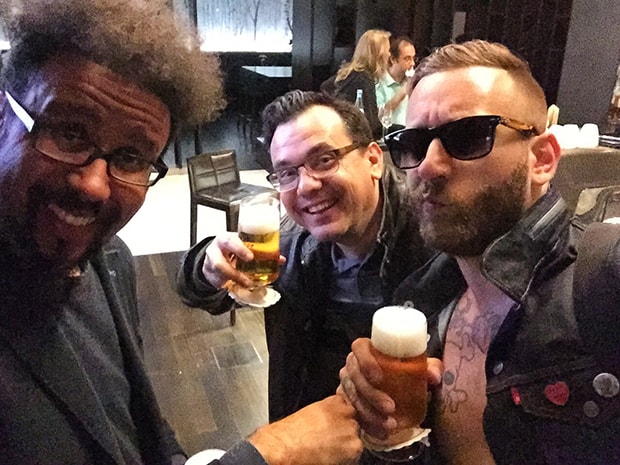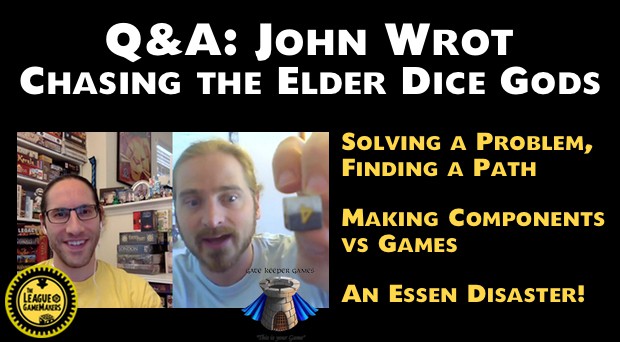
I recently attended one of the biggest tabletop gaming conventions in the world, the International Spieltage in Essen, Germany. I’m used to the tabletop circuit by now, attending between 8-12 shows per year – a variety of trade shows, festivals and traditional board game conventions, but admittedly Essen is a big deal; It’s arguably at the heart of the gaming world, bringing together 41 countries around the tabletop!
NO SPOILERS ABOUT PANDEMIC LEGACY AHEAD
Going to cons is a bit of a game in itself. I’m going to recap a bit of the show setup and then follow a bit of Jamey Stegmaier’s blog format as he does for Gen Con with top 10 highlights and lessons learned. My goal isn’t so much lessons about Spiel itself but things that a giant show floor can teach my small publishing company. This is a big show – what can we take home to our local shows? We’ve had some great convention insights on the blog (links following this article) but some lessons you just need to learn over and over, or become more acute when you’re in a foreign country. After the top 10, stay tuned for a gallery of pics from Essen 2015!
Just a few numbers from this year:
SPIEL 2015 – 910 EXHIBITORS, AND A RECORD 162,000 TURNSTILE ENTRIES!
For those keeping track in Indianapolis, that’s like double the publishers of Gen Con, but I think the US “best four days in gaming” still likely beats out unique visitors (61,000+). Gen Con takes over much of the city and it just feels bigger to me. It’s a close call, but Spiel does have more ‘show floor’ than any con.
Here’s the layout of the land. The yellow highlight shows what part of the convention center was used (not all of it!). Scale is hard to tell here – that green is a massive park, and walking the whole eastern con path is like 15 minutes.
Since I was attending Essen as an exhibitor, this guide will be with a publishing slant, rather than as a player or designer experience. I attended on behalf of my publishing partner, Breaking Games. Breaking Games had about a 6x booth size for this show, with roughly 25-30 games to sell. My company, Squirmy Beast, released 2 of those games in 2015 (Letter Tycoon and Boomtown Bandits) and Spiel was the international debut of both. The games continue on their international tour with Breaking Games at PAX Australia next weekend!
Ok, in no particular order, my top 10 publisher takeaways from Spiel:
- 10. Water. No top 10 list for working a show should be without this item, as obvious as it may be, it’s worth saying again and again. I used to just say this because conventions charge $3-$4 per bottle, but it’s about availability. You and/or your team are selling games for 8-10 hours, trapped in one spot. The nearest water may be far away, behind a line. Your throat is going to go out on you, sometimes mid pitch. Get a case.
- 9. Promotional Materials Some shoutouts here – promoting a game comes in all sizes. Kings Armory had medium sized movie posters which worked well for a booth wall. Gil Hova had business cards for Bad Medicine (not his company, his GAME) – perfect for right by the cash register. Some people don’t want a postcard. I had postcards for Boomtown Bandits and those work outside your booth or great stuffed in a free bag with a customer’s purchase. Steven Bailey had a banner for Billionaire Banshee – great for calling attention to the booth. Which one do YOU need?! All of em. The key is flexibility.
- 8. Catalogs. Catalogs are promotional materials, but they deserve their own line item. You look serious if you have a catalog. I don’t have one yet, but I plan to rectify that situation in 2016. I saw that Passport Studios had finished setting up early on the day before the con and left just a nice spread of their catalog. Classy, and useful. A catalog can speak for you when you’re not there, or give more information after a show – and it works for both customer and retailer or even I might guess a distributor, and it’s reusable. You’re not big enough for a catalog you say? It’s not required, but consider how soon you can implement this.
- 7. This is not a solo experience. This has several meanings for me. Firstly, because I now have more than one game, but there’s still only 1 of me. You can’t demo more than one game at a time. EVEN if you put two smallish tables next to each other. Trust me, I tried it at Toy Fair, and I tried it in Essen. The second meaning is this, I now wear more than one hat. You need many people to pull this off. You need SALES and DEMOS and NETWORKING to be distinct roles.
- 6. Uniforms. I often dress in t-shirt because we as gamers don’t have much of a dress code. I sometimes wear a game logo, my company logo or the league shirt. This is fine for players and designers, but once you are trying to establish yourself and your brand, you need a consistent look. Richard Bliss absolutely is right in the Impressions vidcast on this topic. Tom Vasel was easy to find in his red hat. The Spiel podcast has meeple coats. I’m realizing now that a uniform look to you AND all of your staff is critical. You may want a polo or a bright color – or it can still be a black t-shirt (CGE black comes to mind), but everyone is wearing the same design for four days.
- 5. Know Your Space.This is both understanding your logistical space (Essen booths were longer horizontally, and shorter vertically than a standard US booth) and understanding the customer access and flow to your space. Both of which YOU CANNOT choose. Ideally, assess before the convention begins (if nothing else – day before) what the quirks are. Every convention has quirks. At Indiecade 2014, I was outside in the hot sun, and the wind blew away my signage. At Origins 2016, we had a giant post blocking our booth. At Essen, we were in the back, which meant from 10am to 11am most customers were still wading through hall 1. If there was a networking meeting or game purchase I needed to make, I quickly realized that the morning was the right time to do it.
- 4. Know Your Audience. Spiel presented me with many different customers – some spoke English only a little. Many were looking for a bargain price (and the other show vendors were accommodating that). At IndieCade, it’s mostly poor students, and at BGG.con, the library and play time trumps the sales floor. But at Gen Con for example, customers can and will pay full price. We dropped our prices a bit on day 2 in Essen, losing the import markup. If you can’t or won’t discount your product below MSRP, then you need to look for a promotional angle or value you can add to the experience. It’s not just price either. Think about your target customer – are you doing 20 minute demos or full game plays? At Essen, a quick brief intro was all most people wanted. At the end of the day, you’re looking to connect a consumer to a product, and you have to be ready to adapt to the the customer’s needs.
- 3. Have FUN. It’s a marathon, not a sprint. Pace yourself, and take deep breaths. When you are in a good mood and relaxed, you make the best impression. Sometimes the idea that you have to “capture every sale” will take over and dominate you, and force you to push yourself beyond reasonable amounts. I have been known to skip lunch. Say you’re late on day 1. Don’t sweat it. What if you decide to take a long lunch and you miss a few extra demos at your booth. Don’t worry about those sales. Besides, you never know when you’ll run into your next distributor. I like to leave my evenings open, for any possibility.
- 2. It’s not actually about the games. What the… Food?! Well, in Essen, there is really good food of course, but it’s not about that either. Spiel, like any good show, is full of people. More people, sure, but people just the same. And people working in the same business as you. Shake hands or bump fists. Make time for meetings, make time for hellos at a booth that is not yours and make time for open evenings and game nights. I’m in a developer role, so I make sure I have time for my co-publisher and my designers when they attend shows with me. You make time for volunteers (take them to dinner or get everyone together for breakfast), distributors, fellow booth owners (trades!), and of course, the customers.

- 1. You don’t NEED Essen. Don’t get me wrong – cross this off your list as soon as you can. Come see it for yourself, it’s amazing! And you do need conventions – these are critical to the success of your company. But good news if you’re thinking, “I can’t make it to Spiel or even Gen Con anytime soon.” There’s 900 exhibitors in Essen, 400 at Indianapolis, and what – 35 at your local convention? Community starts somewhere. Build up and make a great experience first for your local area. Grow into these bigger shows.
EXTRA CREDIT:
At 6pm on Sunday, as the show was ending, a member of Taiwan Boardgames Design came over and handed all of us in our booth a free mini game. That’s right, something completely free, at a good time for exhibitors to connect. As a result, I think about his company more, (I have a blogged about it now), and I have a new game to try sometime. Brilliant!
—
GAME CONVENTION MUSINGS AND NETWORKING POSTS
by various authors on the League of Gamemakers.
STEPPING INTO THE BIG LEAGUES AT ESSEN
– by Scott Caputo.
OBSERVATIONS FROM A FIRST TIME GEN CON EXHIBITOR
– by Jeff Cornelius
FESTIVALS, COMIC CONS & TRADESHOWS: THRIVING BEYOND THE GAMING CONVENTION
– by Christina Major
PROMOTING YOUR GAME AT CONS
– by guest authors Tap Pribbenow and Nina Park
GO TO CONS!!! CONNECTING AT CONVENTIONS LIKE KUBLA CON
– by Luke Laurie
HOW TO WORK IN THE GAMING INDUSTRY
– by JR Honeycutt
GO BIG OR GO HOME: RUNNING AN AWESOME EVENT AT A CON
– by Stephen Debaun
—
LAST BUT NOT LEAST, A BUNCH OF PICTURES!
The league collected a bunch of Essen 2015 photos here on Facebook.









